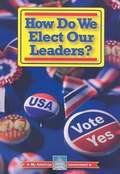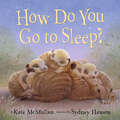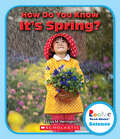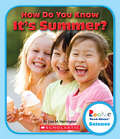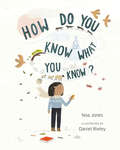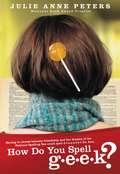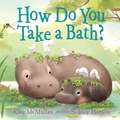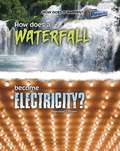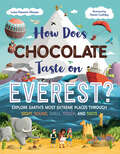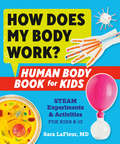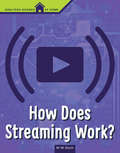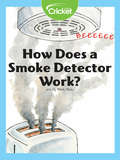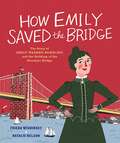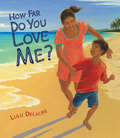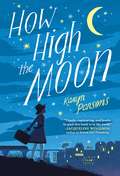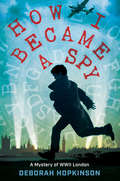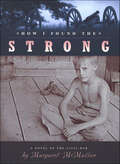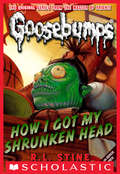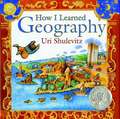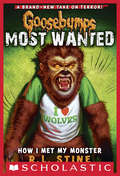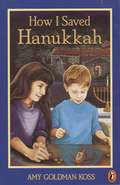- Table View
- List View
How Do We Elect Our Leaders? (My American Government)
by William David ThomasIn what ways are the branches of government like a basketball game? How can a school yard game's rules liken themselves to a constitution? Through engaging analogies and introductions, our new government series gets students ready for election 2008. Correlated to the fourth and fifth grade social studies curriculum, My American Government introduces students to how our government works. Students learn about the U.S. Constitution, the branches of government, citizens' basic rights, and how we elect our leaders.
How Do Weather And Climate Affect Our Lives?: Student Activity Guide
by The Smithsonian InstitutionNIMAC-sourced textbook
How Do You Go to Sleep?
by Kate McMullanDiscover how different animals go to sleep in this rhyming picture book from a veteran children's author! Follow along as three children learn about the bedtime routines of squirrels, parrots, dolphins, and many more. Meerkats sleep in a stack. Is that how these kids go to sleep? Or do they hibernate in snow all winter long like frogs? Or maybe they sleep the day away like skunks? No, that can't be right! By the book's conclusion, the kids have imitated all kinds of animals who are portrayed sleeping in their natural habitats, thanks to Sydney Hanson's charming illustrations. Readers will recognize the way the human child eventually goes to sleep--with stuffed animals, a bedtime story, and a kiss good night!A Bank Street Best Book of the Year "Punctuated with zaniness, McMullan's litany nevertheless offers a quiet, calming rhythm to help little ones nod off."--Kirkus"A bedtime book that will soothe and please children and caregivers."--SLJ"A nice pairing with Diane Muldrow's How Do Giraffes Take Naps?, Vin Vogel's Bedtime for Yeti, or Cari Best&’s I&’m Brave! I&’m Strong! I&’m Five!, particularly for little ones looking for comfort around sleeping in their own beds."--Booklist
How Do You Know What Time It Is?
by Robert E WellsWhat would life be like with no clocks and no calendars? How would you know when to get up in the morning? How would you know when baseball season was about to start? Long, long ago, all people could do was watch the sun and moon and try to figure things out. Eventually, they made simple clocks like sundials. And as time marched on, people came up with more ways to measure it. Today, quartz crystal watches and atomic clocks tell us EXACTLY what time it is, at any moment, all over the world.
How Do You Know What You Know?
by Noa JonesA charming and inquisitive story that celebrates tracing the origin of ideas, language, and every day objects, for children 4–8.Where does snow come from? What language did the word thermos come from? And who was the Buddha's teacher?So many problems in the world come from accepting information at face value without looking into where it comes from. How Do You Know What You Know? follows a child and their father on a cozy, snowy day outing. The child asks questions about how things came to be the way they are. The questions range from how the father knows how to tie a shoe to why it&’s not a good idea to eat yellow snow. These queries are met by the father with patience and humor that weave a delightful narrative of intergenerational knowledge sharing. In this exchange, respectful inquiry is beautifully modeled for young learners.The journey includes an amble in the park, a trip to the library, a bus ride, and a visit to a local Buddhist temple where the father is a student. The teacher there introduces the child to the idea of lineage, that wisdom and understanding comes from generations of knowledge passed down from person to person. With a quaint and welcoming simplicity, the illustrations bring this beautiful story to life, and every spread has a subtle nod to the progression of how things come to be the way they are. The story encourages children&’s natural curiosity and shows them that everywhere they look there is a story to be told if we just ask.
How Do You Lift a Lion?
by Robert E WellsExplore the functions of levers, wheels, and pulleys, and learn how to lift a lion, pull a panda, and deliver a basket of bananas to a baboon birthday party!
How Do You Spell G-E-E-K?
by Julie Anne PetersBest friends Kimberly and Ann both have a dream to make it to the National Spelling Bee in Washington, D.C. Eighth grade is the last year they can qualify, so they are practicing day and night. But when Ann is assigned to sponsor new student Lurlene Brueggemeyer, who turns out to be an amazing speller, suddenly her relationship with Kimberly and her chances of winning the competition are put to the test. If the three girls end up competing against each other for the prize, that can spell only one thing... t-r-o-u-b-l-e.
How Do You Take a Bath?
by Kate McMullanPerfect for fans of Five Little Monkeys Jump in the Bath, this fun and educational picture book brings together adorable baby animals and bathtime.How do YOU take a bath? Does your mama comb your fur?Do you shake off all your dirt?Do you splash and flap and quack?Do the birdies peck your back?No!Follow elephants, pigs, monkeys, hippos, and more in this charming rhyming picture book from veteran author Kate McMullan. How does a pig take a bath? It sinks in the mud! What about a chicken? It thrashes about in dust! And a cat? Why, it licks itself clean, of course! Sydney Hanson's adorable illustrations toggle neatly between animals in nature grooming themselves and humorous depictions of children attempting the animals' bathing tactics. By the end of the book, the child finally makes his way to the bathtub, no mud baths or lick baths about it!
How Does A Waterfall Become Electricity? (How Does It Happen)
by Robert SneddenWhat is the world's tallest waterfall?What is the world's tallest waterfall? How do dams help generate water power? What happens when a waterwheel spins? This series explores the causes and effects that shape our world. From the underwater volcanoes that sprout into islands, to the rushing waterfalls that spark electric currents, this series demonstrates how both natural and man-made phenomena occur.
How Does Chocolate Taste on Everest?: Explore Earth's Most Extreme Places Through Sight, Sound, Smell, Touch, and Taste
by Leisa Stewart-SharpeAn immersive round-the-world adventure, where YOU are the explorer experiencing the most extreme places on earth and doing it all through your five senses.Have you ever wondered what the buzz of the rain forest sounds like on a trek through the Amazon? Or how it feels to experience the biting cold as you voyage across Antarctica? Or how chocolate tastes on Mount Everest? From every heart-bursting sight to tummy-lurching smell, you will experience them all–and do so without having to leave the comforts of your couch.This funny and fast-paced interactive thrill ride that young adventure-seekers are sure to enjoy is chock-full of facts, history, and survival tips peppered on every page.
How Does My Body Work? Human Body Book for Kids: STEAM Experiments and Activities for Kids 8-12
by Sara LaFleurHow does your body work? This fun human anatomy book helps kids 8-12 answer that question through awesome, hands-on STEAM/STEM experiments and activities.Entertaining and interactive, The Human Body Book for Kids shows curious kids how their body systems help them move, breathe, fight infections, and keep them alive!Filled with fascinating information about human anatomy, this exciting science book features: • More than 40 STEAM experiments and activities that help kids learn about their amazing bodies. • Full-color illustrations and photographs that highlight the cells, tissues, organs and body systems as well as explain the steps and outcomes of the experiments. • A doctor author, an MD who works with both children and adults and is an expert on the human body inside and out. • Weird and wonderful facts about the human body: Did you know that you&’re about 1 cm taller in the morning than the evening? That a baby is born with 300 bones but has only 206 by the time they&’re an adult? That some children are born with an extra set of ribs surrounding the lungs called &“gorilla ribs&”? • Learning and fun together: Kids will create models, eat experiments, and show off their STEAM skills to family and friends. Endorsed by the co-founder of Apple&’s Siri, this educational book is a great resource for answering kids&’ questions about how their bodies work.
How Does Streaming Work? (High Tech Science at Home)
by M. M. EbochWhether you're watching a movie, bingeing on a classic TV show, or listening to your favorite song, you're probably streaming it. Videotapes, DVDs, and CDs are mostly just memories now. Streaming puts a world of options at your fingertips when you’re at home and, with a smartphone or tablet, when you're on the go. Find out how streaming was invented, how it works, and what the future might hold for this part of a high-tech life.
How Does a Smoke Detector Work?
by Liz HuyckEver wonder why a smoke alarm goes off? A battery, siren, and metal can work together to detect smoke and sound the alarm when catching a whiff of smoke.
How Emily Saved the Bridge: The Story of Emily Warren Roebling and the Building of the Brooklyn Bridge
by Frieda WishinskyThe amazing story of Emily Warren Roebling, the woman who stepped in to oversee the construction of the Brooklyn Bridge, which was completed in 1883.Emily was not an engineer, but she was educated in math and science. She married Washington Roebling, the chief engineer of the famous bridge. When Washington became ill from decompression sickness, Emily stepped in, doing everything from keeping the books, to carrying messages for her husband, to monitoring the construction of the bridge. She was the first person to cross the Brooklyn Bridge when it opened.Emily, who went on to study law among many other accomplishments, is an inspiration to all, as demonstrated through Frieda Wishinsky’s informative and engaging text and Natalie Nelson’s distinctive collage illustrations. Speech bubbles revealing imagined dialogue add a playful note to this historical account, which includes fascinating facts about the Brooklyn Bridge and a further reading list.Key Text Featuresfurther readingspeech bubblesCorrelates to the Common Core State Standards in English Language Arts:CCSS.ELA-LITERACY.RL.2.1Ask and answer such questions as who, what, where, when, why, and how to demonstrate understanding of key details in a text.CCSS.ELA-LITERACY.RL.4.3Describe in depth a character, setting, or event in a story or drama, drawing on specific details in the text (e.g., a character's thoughts, words, or actions).
How Far Do You Love Me?
by Lulu DelacreThis unique bedtime book by award-winning author-illustrator Lulu Delacre features a game that highlights the universal love between caregivers and children while taking readers on a journey across the seven continents of Earth.How far do you love me?I love you to the top of the peakslit by the morning sun ...To the crests of the desert where the wind sweeps sand from the dunes ... Based on a bedtime game that author-illustrator Lulu Delacre played with her young daughters, How Far Do You Love Me? is an "I love you" book with a twist. With every expression of love, readers visit a different location around the world, each a beautifully illustrated scene of caregivers and children in a place of natural beauty. The intimate size of the book is just right for sharing and snuggling up close with a child. As bedtime--or any quiet time--approaches, gather close with a special person in your life and get ready to let your imagination soar to place after place as you embark on a game of "How far do you love me?" The possibilities are endless!
How High the Moon
by Karyn ParsonsTo Kill a Mockingbird meets One Crazy Summer in this powerful, bittersweet debut about one girl's journey to reconnect with her mother and learn the truth about her father in the tumultuous times of the Jim Crow South. <P><P> Dreaming In the small town of Alcolu, South Carolina, in 1944, 12-year-old Ella spends her days fishing and running around with her best friend Henry and cousin Myrna. But life is not always so sunny for Ella, who gets bullied for her light skin tone, and whose mother is away pursuing a jazz singer dream in Boston. So Ella is ecstatic when her mother invites her to visit for Christmas. Little does she expect the truths she will discover about her mother, the father she never knew and her family's most unlikely history. And after a life-changing month, she returns South and is shocked by the news that her schoolmate George has been arrested for the murder of two local white girls. <P><P> Bittersweet and eye-opening, How High the Moon is a timeless novel about a girl finding herself in a world all but determined to hold her down.
How I Became a Spy: A Mystery of WWII London
by Deborah HopkinsonFrom the award-winning author of The Great Trouble comes a story of espionage, survival, and friendship during World War II.Bertie Bradshaw never set out to become a spy. He never imagined traipsing around war-torn London, solving ciphers, practicing surveillance, and searching for a traitor to the Allied forces. He certainly never expected that a strong-willed American girl named Eleanor would play Watson to his Holmes (or Holmes to his Watson, depending on who you ask).But when a young woman goes missing, leaving behind a coded notebook, Bertie is determined to solve the mystery. With the help of Eleanor and his friend David, a Jewish refugee--and, of course, his trusty pup, Little Roo--Bertie must decipher the notebook in time to stop a double agent from spilling the biggest secret of all to the Nazis.From the author of The Great Trouble, this suspenseful WWII adventure reminds us that times of war call for bravery, brains and teamwork from even the most unlikely heroes.
How I Found the Strong
by Margaret McMullanIt is the spring of 1861, and the serenity of Smith County, Mississippi, has been shattered by Abraham Lincoln’s declaration of war on the South. Young and old are taking up arms and marching off to war. But not ten-year-old Frank Russell. Although he is eager to enlist in the Confederate army, he is not allowed. He is too young, too skinny, too weak. After all, he’s just “Shanks,” the baby of the Russell family. War has a way of taking things away from a person, mercilessly. And this war takes from Frank a mighty sum. It’s nabbed his Pa and older brother. It’s stolen his grandfather, his grandmother. It has robbed Frank of a simpler way of life, food, his boyhood. And gone are his idealistic dreams of heroic battles and hard-fought victories. Now all that replaces those images are questions: Will I ever see my father and brother again? Why are we fighting this war? Are we fighting for the wrong reasons? Will things ever be the same around here?
How I Got My Shrunken Head (Classic Goosebumps #10)
by R. L. StineGoosebumps now on Disney+!What has two eyes, a mouth, and wrinkly green skin? Mark's shrunken head! It's a present from his Aunt Benna. A gift from the jungle island of Baladora.And Mark can't wait to show the kids at school!But late one night the head starts to glow. Because it's actually no ordinary head. It gives Mark a strange power. A magical power. A dangerous power...Now with all-new bonuses including an author interview, gross-out facts, and more!
How I Learned Geography
by Uri ShulevitzHaving fled from war in their troubled homeland, a boy and his family are living in poverty in a strange country. Food is scarce, so when the boy's father brings home a map instead of bread for supper, at first the boy is furious. But when the map is hung on the wall, it floods their cheerless room with color. As the boy studies its every detail, he is transported to exotic places without ever leaving the room, and he eventually comes to realize that the map feeds him in a way that bread never could. <P><P> The award-winning artist's most personal work to date is based on his childhood memories of World War II and features stunning illustrations that celebrate the power of imagination. An author's note includes a brief description of his family's experience, two of his early drawings, and the only surviving photograph of himself from that time. How I Learned Geography is a 2009 Caldecott Honor Book.
How I Met My Monster (Goosebumps Most Wanted #3)
by R. L. StineGoosebumps now on Disney+!Noah Bienstock can't help being so shy and nervous; he's always been like that. His best friend, Lissa Gardener, lives in the same building, but aside from her, Noah isn't very popular. So when he learns that the new student in his class is also his neighbor, Noah's excited to have a new person to out with. But as the boys spend more time together, Noah starts to worry all over again--is there something strange about his new friend?
How I Saved Hanukkah
by Amy Goldman Koss Diane DegroatA Hanukkah to remember - finally! Marla Feinstein, the only Jewish kid in her fourth-grade class, knows what this holiday season will be like. While everyone else is decorating trees and hanging stockings, she'll be forgetting to light the candles and staring at a big plastic dreidel. But when Marla decides to learn what the Hanukkah traditions are really about, things change fast. Soon she's got her family turning latkes into Hanukkah Performance Art and doing a wild hora. And by the end of this funny and heartwarming novel, the Festival of Lights is the biggest party in town!
